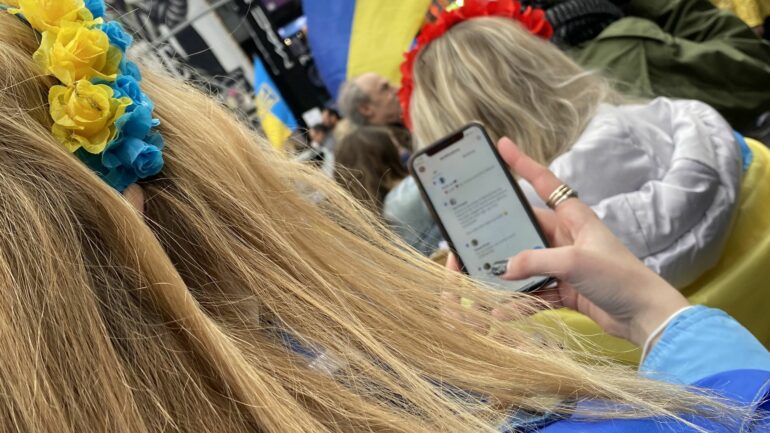The first major study of social media behavior during wartime has found that posts celebrating national and cultural unity in a country under attack receive significantly more online engagement than derogatory posts about the aggressors.
University of Cambridge psychologists analyzed a total of 1.6 million posts on Facebook and Twitter (now X) from Ukrainian news outlets in the seven months prior to February 2022, when Russian forces invaded, and the six months that followed.
Once the attempted invasion had begun, posts classified as expressing Ukrainian “ingroup solidarity” were associated with 92% more engagement on Facebook, and 68% more on Twitter, than similar posts had achieved prior to Russia’s full-scale attack.
While posts expressing “outgroup hostility” towards Russia only received an extra 1% engagement on Facebook after the invasion, with no significant difference on Twitter.
“Pro-Ukrainian sentiment, phrases such as Glory to Ukraine and posts about Ukrainian military heroism, gained huge amounts of likes and shares, yet hostile posts aimed at Russia barely registered,” said Yara Kyrychenko, from Cambridge’s Social Decision-Making Lab (SDML) in its Department of Psychology.
“The vast majority of research on social media uses US data, where divisive posts often go viral, prompting some scholars to suggest that these platforms drive polarization. In Ukraine, a country under siege, we find the reverse,” said Kyrychenko, lead author of the study published in Nature Communications.
“Emotions that appeal to ingroup identity can empower people and boost morale. These emotions may be more contagious, and prompt greater engagement, during a time of active threat—when the motivation to behave beneficially for one’s ingroup is heightened.”
Previous research from the same Cambridge lab found that going viral on US social media is driven by hostility: posts that mock and criticize the opposing sides of ideological divides are far more likely to get engagement and reach larger audiences.
The new study initially used the same techniques, finding that—prior to the invasion –social media posts from pro-Ukrainian as well as pro-Russian news sources that contained keywords of the “outgroup”—opposing politicians, placenames, and so on— did indeed generate more traction than posts containing “ingroup” keywords.
However, researchers then trained a large language model (LLM)—a form of language-processing AI, similar to ChatGPT—to better categorize sentiment and the motivation behind the post, rather than simply relying on keywords, and used this to analyze Facebook and Twitter posts of Ukrainian news outlets before and after the invasion.
This deeper dive revealed a consistently strong engagement rate for solidarity posting—higher than for “outgroup hostility”—in the lead up to Russia’s attack, which leaps even further after the invasion, while interactions with derisive posts about Russia flatline.
Lastly, a separate dataset of 149,000 post-invasion Tweets that had been geo-located to Ukraine was fed into a similar LLM, to test this effect on social media posts from the Ukrainian population, rather than only news sources.
Tweets—now X posts—from the Ukrainian public containing messages of “ingroup solidarity” championing Ukraine were likely to get 14% more engagement, while those expressing antagonism to Russians were likely to gain only a 7% increase.
“Social media platforms allow expressions of the national struggle that would otherwise have been private to reach millions,” said Kyrychenko.
“These moments echo solidarity and resistance from a first-person account, which can make them more powerful than traditional media rooted in impersonal reporting.”
Researchers acknowledge these trends may result from algorithms used by social media companies, but say the fact that similar effects were detected on two separate platforms, and with posts from both Ukraine’s news sources and its citizenry, suggests much of this information-sharing dynamic is driven by people.
“The Kremlin has long tried to sow division in Ukraine, but fails to understand that the Euromaidan revolution and Russia’s attempted invasion have only spurred Ukrainian identity towards national unity,” said Dr. Jon Roozenbeek, study senior author from Cambridge’s SDML as well as King’s College London.
“We can trace through social media posts this fortification of Ukrainian group identity in the face of extreme Russian aggression,” said Roozenbeek, who published the book Propaganda and Ideology in the Russian–Ukrainian War earlier this year.
Kyrychenko, a Cambridge Gates Scholar born and raised in Kyiv, recalls the critical role Facebook and Twitter played in the Euromaidan protests in 2014, some of which she participated in as a teenager, and her surprise at the attitude towards social media she encountered in the US after moving there to study in 2018, during the Trump presidency.
“By the time I arrived in the US, social media was seen as toxic and divisive, whereas my experience of these platforms in Ukraine had been as a force for positive political unity in the fight for democracy,” said Kyrychenko.
While Kyrychenko points out that hate speech and conspiracy theories still thrive online in Ukraine, she argues that the solidarity fostered on social media reflects some of the early promise these platforms held for uniting people against tyranny.
“The Ukrainian experience reminds us that social media can be used for good, pro-social causes, even in the direst of situations.”
Examples of social media posts that were part of the study’s dataset:
Ingroup solidarity examples include:
“Thanks to the KALUSH ORCHESTRA band for their support! Glory to Ukraine! 🇺🇦” got 4434 retweets.
“Our flag will fly over all of Ukraine, said General Valery Zaluzhnyi.” got 5577 favorites and 767 retweets.
“Ukrainian soldiers congratulate students with September 1 and remembers their first bells 💔🔔” … got 92381 shares and 482896 likes on Facebook.
“In a Polish church, they decided to sing the song “Oh, there’s a red viburnum in the meadow” right during the service! 🇺🇦 ❤️🇵🇱” … got 34897 shares and 68847 likes on Facebook.
A further description from lead author Yara Kyrychenko of an example of Ukrainian ‘ingroup solidarity’ social media content:
“On New Year’s Eve 2022, a family in the then recently de-occupied Ukrainian city of Kherson watched Volodymyr Zelensky’s presidential address over WhatsApp with their relatives in the still-occupied territories.
“A video of the entire family crying—as Zelensky states Ukraine will liberate and rebuild—quickly went viral across platforms. It captured something so powerful and deeply emotional that watching it makes many cry, even months later.
“The sense of unity despite barriers, the tender cherishing of the national tradition, and the human connection—all distilled into one TikTok. Posts like these evoke similar feelings of solidarity in countless Ukrainians, even though each has seen a different face of the war.”
Outgroup hostility examples include:
“Boris Johnson: negotiating with Putin is like negotiating with a crocodile” got 425 retweets and 4957 favorites.
“It hurts to understand that these bastards shoot absolutely everything. It doesn’t matter if the military is there or not. Hospitals, schools….” got 21728 Shares and 25125 Likes.
“❗️Russians don’t want to fight for Putin. The story of a soldier captured in Kharkov. ‘Bastards! I hate them! They are making propaganda!'” … got 65409 shares and 79735 Likes.
More information:
Social identity correlates of social media engagement before and after the 2022 Russian invasion of Ukraine, Nature Communications (2024). DOI: 10.1038/s41467-024-52179-8
Provided by
University of Cambridge
Citation:
Solidarity drives online virality in a nation under attack, study of Ukrainian social media reveals (2024, October 1)



